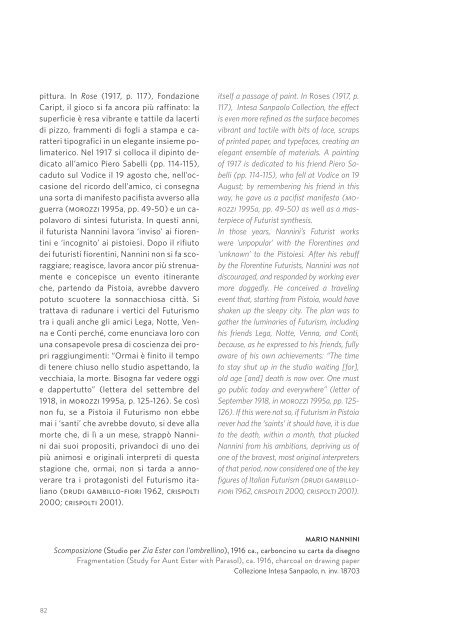Pistoia Novecento 1900 - 1945
a cura di / curated by Annamaria Iacuzzi Philip Rylands
a cura di / curated by
Annamaria Iacuzzi
Philip Rylands
Create successful ePaper yourself
Turn your PDF publications into a flip-book with our unique Google optimized e-Paper software.
pittura. In Rose (1917, p. 117), Fondazione<br />
Caript, il gioco si fa ancora più raffinato: la<br />
superficie è resa vibrante e tattile da lacerti<br />
di pizzo, frammenti di fogli a stampa e caratteri<br />
tipografici in un elegante insieme polimaterico.<br />
Nel 1917 si colloca il dipinto dedicato<br />
all’amico Piero Sabelli (pp. 114-115),<br />
caduto sul Vodice il 19 agosto che, nell’occasione<br />
del ricordo dell’amico, ci consegna<br />
una sorta di manifesto pacifista avverso alla<br />
guerra (morozzi 1995a, pp. 49-50) e un capolavoro<br />
di sintesi futurista. In questi anni,<br />
il futurista Nannini lavora ‘inviso’ ai fiorentini<br />
e ‘incognito’ ai pistoiesi. Dopo il rifiuto<br />
dei futuristi fiorentini, Nannini non si fa scoraggiare;<br />
reagisce, lavora ancor più strenuamente<br />
e concepisce un evento itinerante<br />
che, partendo da <strong>Pistoia</strong>, avrebbe davvero<br />
potuto scuotere la sonnacchiosa città. Si<br />
trattava di radunare i vertici del Futurismo<br />
tra i quali anche gli amici Lega, Notte, Venna<br />
e Conti perché, come enunciava loro con<br />
una consapevole presa di coscienza dei propri<br />
raggiungimenti: “Ormai è finito il tempo<br />
di tenere chiuso nello studio aspettando, la<br />
vecchiaia, la morte. Bisogna far vedere oggi<br />
e dappertutto” (lettera del settembre del<br />
1918, in morozzi 1995a, p. 125-126). Se così<br />
non fu, se a <strong>Pistoia</strong> il Futurismo non ebbe<br />
mai i ‘santi’ che avrebbe dovuto, si deve alla<br />
morte che, di lì a un mese, strappò Nannini<br />
dai suoi propositi, privandoci di uno dei<br />
più animosi e originali interpreti di questa<br />
stagione che, ormai, non si tarda a annoverare<br />
tra i protagonisti del Futurismo italiano<br />
(drudi gambillo-fiori 1962, crispolti<br />
2000; crispolti 2001).<br />
itself a passage of paint. In Roses (1917, p.<br />
117), Intesa Sanpaolo Collection, the effect<br />
is even more refined as the surface becomes<br />
vibrant and tactile with bits of lace, scraps<br />
of printed paper, and typefaces, creating an<br />
elegant ensemble of materials. A painting<br />
of 1917 is dedicated to his friend Piero Sabelli<br />
(pp. 114-115), who fell at Vodice on 19<br />
August; by remembering his friend in this<br />
way, he gave us a pacifist manifesto (morozzi<br />
1995a, pp. 49-50) as well as a masterpiece<br />
of Futurist synthesis.<br />
In those years, Nannini’s Futurist works<br />
were ‘unpopular’ with the Florentines and<br />
‘unknown’ to the Pistoiesi. After his rebuff<br />
by the Florentine Futurists, Nannini was not<br />
discouraged, and responded by working ever<br />
more doggedly. He conceived a traveling<br />
event that, starting from <strong>Pistoia</strong>, would have<br />
shaken up the sleepy city. The plan was to<br />
gather the luminaries of Futurism, including<br />
his friends Lega, Notte, Venna, and Conti,<br />
because, as he expressed to his friends, fully<br />
aware of his own achievements: “The time<br />
to stay shut up in the studio waiting [for],<br />
old age [and] death is now over. One must<br />
go public today and everywhere” (letter of<br />
September 1918, in morozzi 1995a, pp. 125-<br />
126). If this were not so, if Futurism in <strong>Pistoia</strong><br />
never had the ‘saints’ it should have, it is due<br />
to the death, within a month, that plucked<br />
Nannini from his ambitions, depriving us of<br />
one of the bravest, most original interpreters<br />
of that period, now considered one of the key<br />
figures of Italian Futurism (drudi gambillofiori<br />
1962, crispolti 2000, crispolti 2001).<br />
MARIO NANNINI<br />
Scomposizione (Studio per Zia Ester con l’ombrellino), 1916 ca., carboncino su carta da disegno<br />
Fragmentation (Study for Aunt Ester with Parasol), ca. 1916, charcoal on drawing paper<br />
Collezione Intesa Sanpaolo, n. inv. 18703<br />
82 83













